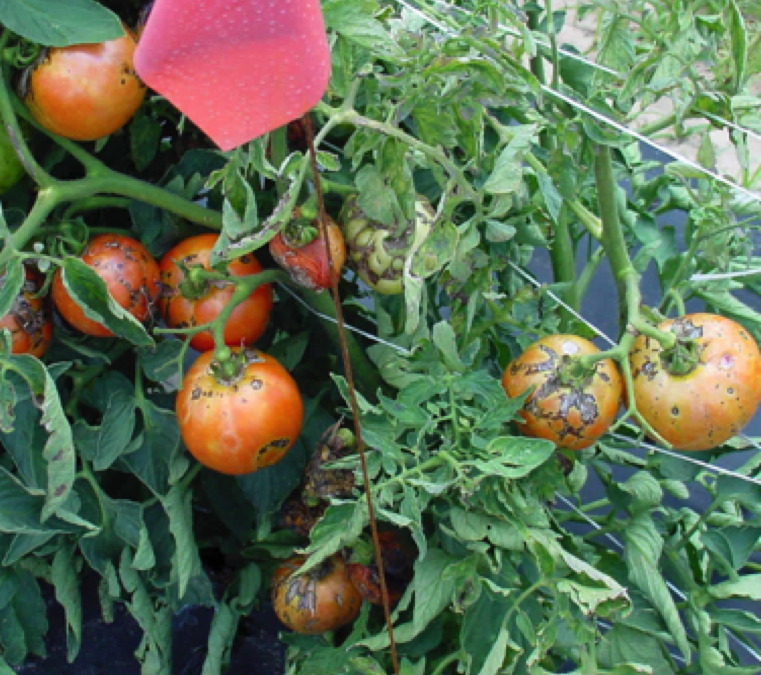
by Matthew Orwat | Feb 25, 2021
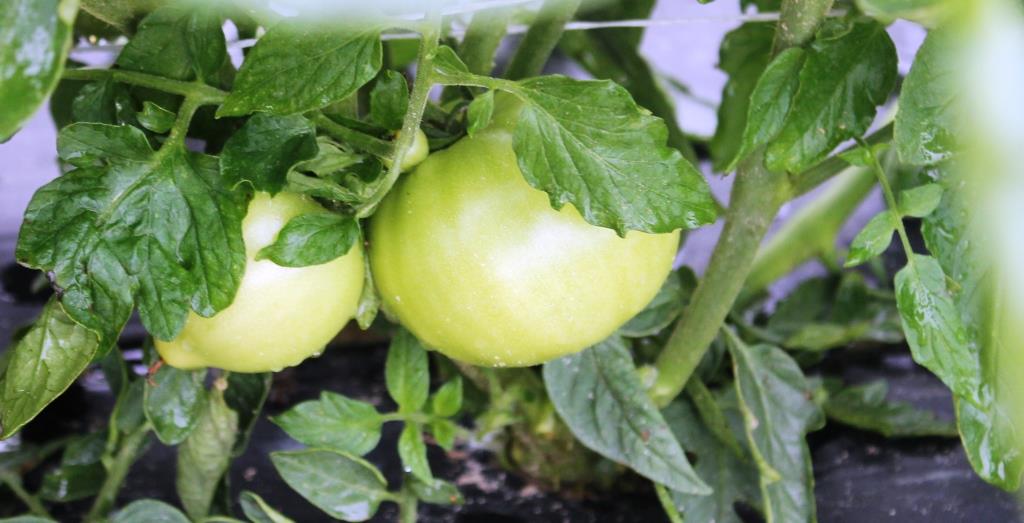
Tomatoes ripening on the vine – Image Credit Matthew Orwat UF/IFAS Extension
It is late-February, so the spring growing season is just around the corner. Now is the time to be thinking about which tasty tomatoes you want to plant in your home garden! Although tomatoes are a favorite kitchen staple, they prove challenging to grow in the Florida Panhandle climate.
While many tomato diseases can kill plants, damage fruit, and reduce yields, genetic resistance or tolerance to select diseases exist. The following are three of the most common diseases and viruses home gardeners face, for which resistant and tolerant varieties exist.
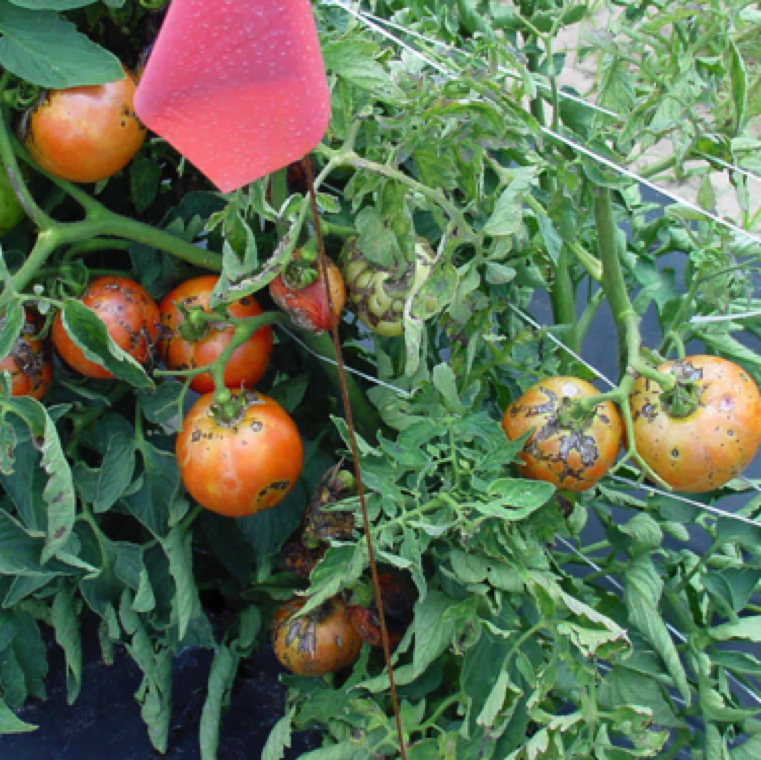
Tomato spotted wilt affects tomatoes, and numerous other vegetables, ornamentals, field crops and weeds. The disease can cause significant yield losses of tomato. Image Credit UF/IFAS Plant Pathology UScout Site
Tomato Spotted Wilt (TSW) is a viral disease which is transmitted by thrips, a species of insect that is very small and not always visible when checking the garden for insect pests. They love to feed on the sugary juices of the tomato flowers, and while feeding, they have the opportunity to transmit the virus through their piercing and sucking mouth parts. Lots of different symptoms may occur with TSW. Initially growers will notice light or dark brown spots on leaves of affected tomatoes, next wilting or stunting will occur, along with brown or purple streaks on the stems. Finally, fruit will exhibit unsightly brown rings throughout. The good news is that home gardeners can get a head start on this disease by planting resistant cultivars. When shopping for seed or transplants, growers should look for plants listed with the codes TSW or TSWV, because these have demonstrated resistance to Tomato Spotted Wilt Virus.
Another viral disease often found in the tomato garden is Tomato Yellow Leaf Curl (TYLC) Virus. TYLC first appeared in Miami in 1997 and was brought to Florida by infected whiteflies. Much like TSW, TYLC is spread from plant to plant by feeding whiteflies. As the name indicates, TYLC symptoms include curled leaves and stunted growth. Infected plants produce little to no fruit. Strategies to reduce the possibility of virus transmission to the garden include reducing the population of weedy plants, which may harbor whiteflies. Fortunately, resistant cultivars are available in plant catalogs, and are denoted by TYLC to indicate resistance.
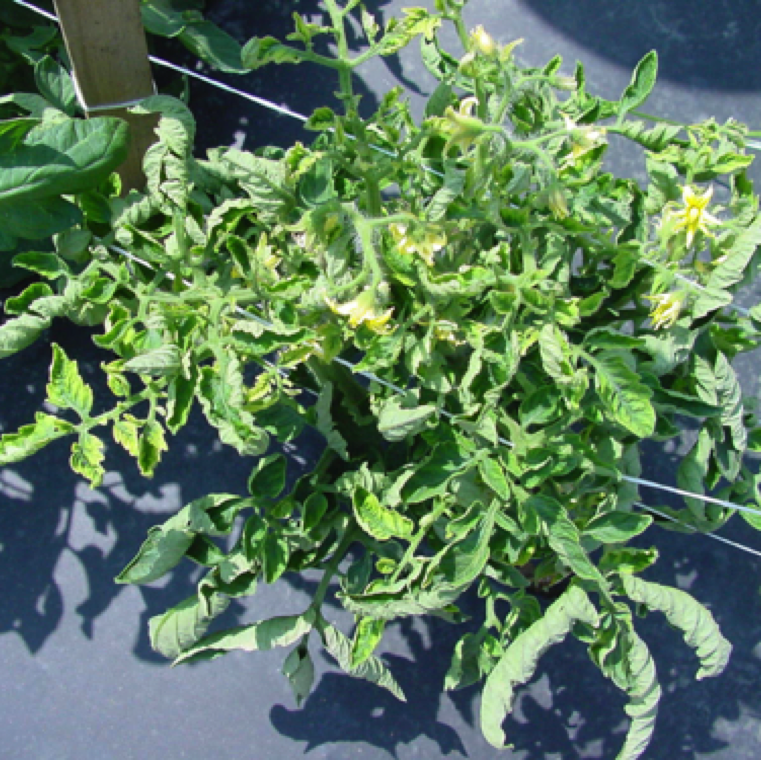
Spread of TYLC is by the feeding of TYLCV infected adult whiteflies. Mechanical or seed transmission is not known to occur. Upward curling and yellowing of the leaves is an early symptom. Credit: UF/IFAS Plant Pathology UScout Site
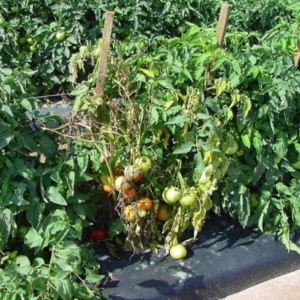
Blighting of leaves and wilting of part or entire plant can expose fruits to sunscalding thereby further affecting yield of affected plants in production. Credit: UF/IFAS Plant Pathology UScout Site
Fusarium Wilt is one of the oldest diseases to affect tomatoes in the state of Florida and is caused by the fungal pathogen Fusarium oxysporum f.sp. lycopersici races 1, 2, or 3. This pathogen is often present in regional soils and moved by wind. Once it enters the roots of tomato plants, fusarium wilt proliferates and clogs the vascular system, much like a clog in the plumbing of a building. Thus, the primary symptom is the wilting of the plant, which will first be noticeable on hot days, despite adequate irritation. Once infected, there is no cure, and infected plants should be removed and destroyed to stop the spread. The good news is that resistant cultivars are available to the various fusarium races. They are usually denoted as F-R 1, 2, or 3 in seed catalogs. Additionally, look for plants labeled VFN. These cultivars are resistant to a different kind of wilt, called verticillium, as well as fusarium and nematodes.
Fortunately, the UF / IFAS publication “Tomato Varieties for Florida—Florida “Red Rounds,” Plums, Cherries, Grapes, and Heirlooms” by Monica Ozores-Hampton and Gene McAvoy has provided us with a handy chart of tomato varieties with disease resistance. Codes in the columns indicate disease resistance to specific pathogens. While there is no single tomato variety resistant to all possible disease pathogens, planting different varieties with several different types of resistance will allow growers to hedge against attack by a number of potential disease problems. Some of the more common disease resistant tomato varieties planted in this area are ‘Quincy’, ‘Bella Rosa’, ‘Amelia’, ‘Tasti-Lee’, ‘BHN 602’, and ‘Volante’.
For a further look at the various diseases of tomato, the EDIS publication “A Series on Diseases in the Florida Vegetable Garden: TOMATO” offers more detail. Another resource UF/IFAS offers for disease diagnosis is the NFREC U-Scout website. U-Scout provides information on more than 40 potential disease issues in tomato. Additionally, any plant disease can be diagnosed through your County Extension Office or by submitting samples to the Plant Pathology Clinic, at the North Florida Research and Education Center, for only $30/sample for basic services.
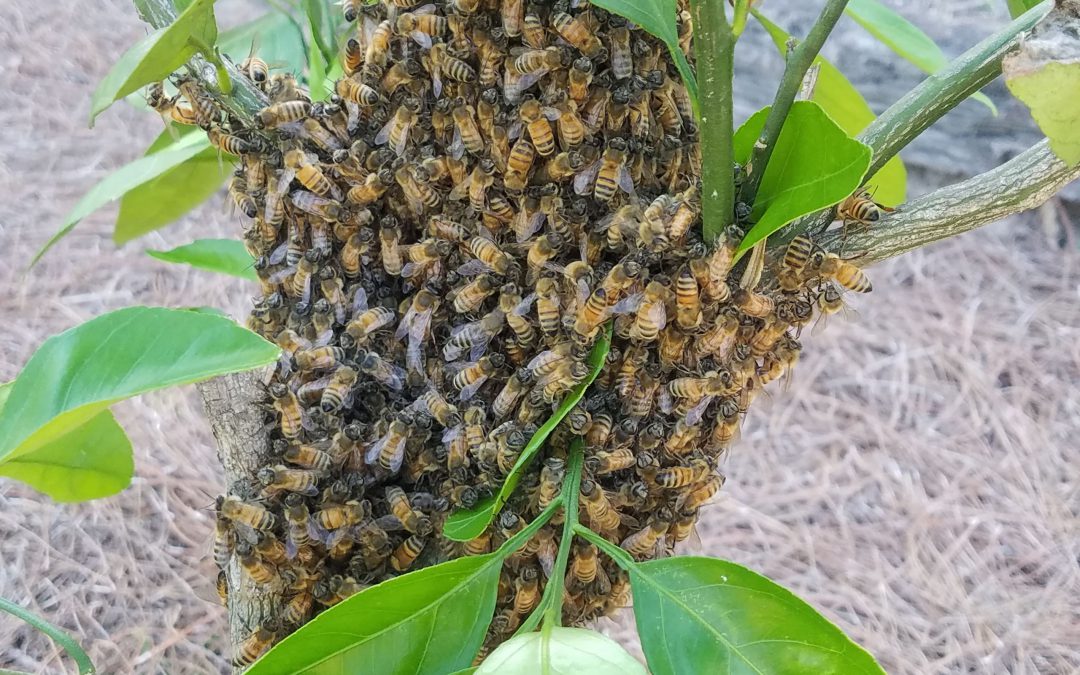
by Evan Anderson | Feb 25, 2021
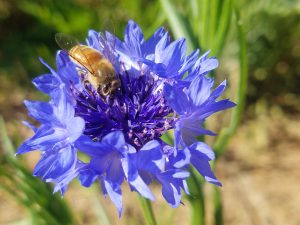
A worker bee gathering nectar and pollen.
As the weather warms, it seems that all kinds of living things start stirring. From birds to bees, plants to ants, and gnats to tourists, the world comes alive in the spring. It’s those bees we’ll discuss here, because every year they swarm, and that can cause some consternation among the homeowners whose houses they invade.
Honeybees are vitally important to our wellbeing, as they act as pollinators for many of our crops. They supply us with honey and wax and are a source of livelihood for many individuals. Important though they may be, they can sometimes become a nuisance.
Honeybees are eusocial organisms. Each honeybee lives in a colony or hive that it cannot survive without. In fact, it can be helpful to think of the entire hive as a single organism, even if it is made up of many individuals. The queen bee is the only one who lays eggs, but she cannot forage for her own food. Workers supply pollen and nectar to the hive but cannot reproduce on their own. Drones, or male bees, exist only to mate and would quickly die without the support of their sisters.
When a queen reproduces, she lays eggs that develop into new workers. When the time is right, she may lay eggs that develop into drones, or new females may be fed a substance called royal jelly that causes them to develop into new queens. These new drones and queens are born in preparation for a new hive to be created rather than to add more bees to the existing one. The old queen will be the adventurous one, so the workers put her on a diet. Once she has lost weight (to make it easier for her to fly), she takes half the workers in the hive and goes out in search of a new place to live. One of the new queens, after mating, returns to the nest and prepares to continue the work of her predecessor.
When the old queen leaves with her coterie, this is called a swarm. When weather warms and nectar begins to flow, the
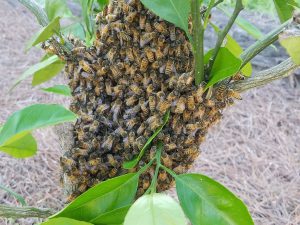
A swarm of bees looking for a new home.
bees travel from place to place looking for a good spot to live. Hollow cavities in trees are a favorite spot, but bee scouts often find what they think are perfect living places in our homes or sheds. While they are searching for a new place to set up shop, they may rest on trees or branches in large clumps. Do not be alarmed if you see one, as it does not mean they are nesting where they’ve stopped. Wait a while to see if they leave on their own or contact a local beekeeper to see if they want to collect the swarm.
If bees have taken up residence somewhere they’re not welcome, there are companies and individuals who may be able to collect the bees rather than destroying them. If removal is not an option, nuisance bees may be eradicated under Florida law, but this must be done by a certified Pest Control Operator.
If you have a swarm or hive on your property, check with the Department of Agriculture (Bee Removal or Eradication in Florida Resources) to find information and for a list of bee removal specialists. See our EDIS publication on choosing a pest control operator at Choosing the Right Pest Control Operator for Honey Bee Removal: A Consumer Guide. You can also contact your local Extension office for help with finding someone local.
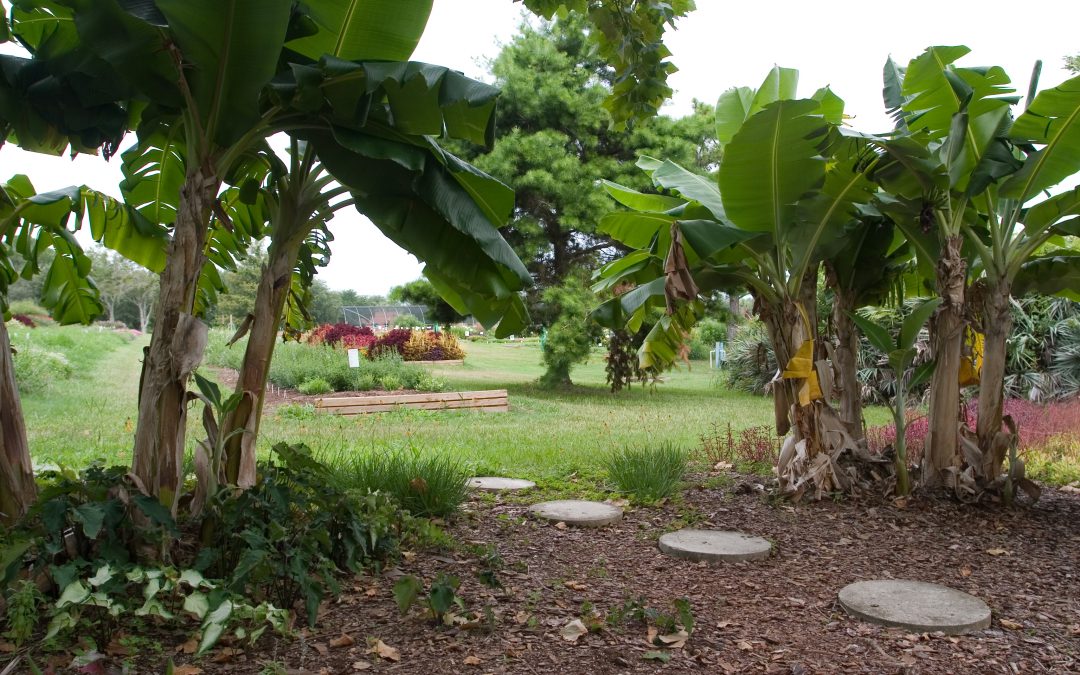
by Ray Bodrey | Feb 25, 2021
Bananas are a great choice for your landscape, whether as an edible fruit producer or simply as an ornamental, giving your space a tropical vibe.
Bananas are native to southeast Asia, however, grow well across Florida. Complementary plants that can be paired with bananas in the landscape are bird of paradise (banana relative), canna lily, cone ginger, philodendron, coontie, and palmetto palm, just to name some.
Bananas are very easy to manage during the warmer months. Bananas are water loving, and that’s putting it lightly. Planting in vicinity of an eave on your home is a good measure for site suitability. Roof rainwater will drastically increase the growth of the banana tree and decrease the need for supplemental irrigation. Banana trees will need full sun and high organic moist soils create the best environment. For nutrition, a seasonal one-pound application of 6-2-12 fertilizer is a good practice to sustain older trees. Young trees should be fertilized every two months for the first year at a rate of a half-pound.
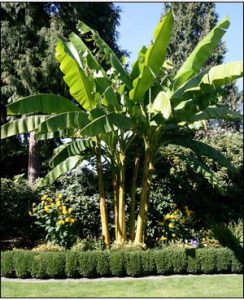
Musa basjoo is one of the most cold hardy banana varieties. Photo Credit: University of Florida/IFAS Extension
If there is a con to banana trees, it’s their cold hardiness. Some varieties fair well and others some not so much. ‘Dwarf Cavendish’ (Musa acuminate) is a popular variety that is found in many garden centers in the state. It produces fruit very well, but it is not very cold hardy. ‘Pink Velvet’ (Musa velutina) produces fruit with a bright pink peel, but isn’t very cold hardy either. A couple of cold hardy ornamental varieties are the ‘Japanese Fiber’ (Musa basjoo) and ‘Black Thai’ (Musa balbisiana), which is by far the most cold hardy, with the ability to easily combat below freezing temperatures.
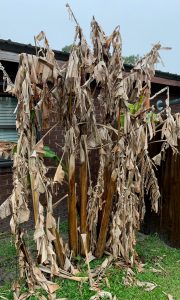
Freeze damage on a banana tree. Photo Credit: Ray Bodrey, University of Florida Extension – Gulf County
Regardless of cold hardiness, in many cases, banana trees will turn brown after freezing temperatures occur or even if the temperatures reach just above the freezing mark, but will bounce back in the spring. Until then, it’s important not to prune away the brown leaves or trunk skin. These leaves act as an insulator and help defend against freezing temperatures. Usually, the last freezing temperatures that may occur in the Panhandle are around the first of April. So, to be safe, pruning can begin by mid to late April. When pruning, be sure to be equipped with a sharp knife, gloves and work clothes. Banana trunk skin and leaves can be quite fibrous and the liquid from the tree can stain clothing and hands.
So, what’s the best variety of fruiting bananas? Most ornamental bananas do not produce tasty fruit. If you are looking for a production banana, ‘Lady Finger’, ‘Apple’, and ‘Ice Cream’ are popular varieties, but are better suited for the central and southern parts of the state.
For more information, contact your local county extension office.
Supporting information for this article can be found on the UF/IFAS Gardening Solutions website.
Also, for more information see the UF/IFAS EDIS publication, “Banana Growing in the Florida Home Landscape”, by Jonathan H. Crane and Carlos F. Balerdi.
UF/IFAS Extension is an Equal Opportunity Institution.
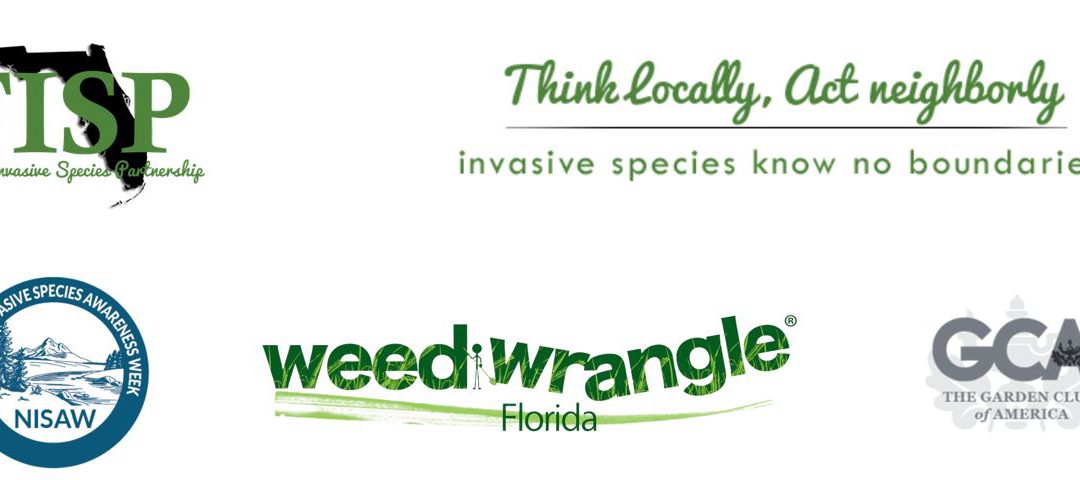
by Mark Tancig | Feb 25, 2021

February 22-26, 2021 is National Invasive Species Awareness Week.
February 22 to 26, 2021 is National Invasive Species Awareness Week (NISAW). This is a time where many organizations involved with land management and conservation will be sharing information to educate the public about the issue of invasive plant and animal species. Living in Florida, we should all be well aware of the concerns with invasive species as we have experience with many, including the fire ant, kudzu, iguanas, climbing fern, and pythons. Oh my! Due to Florida’s climate and our many active ports, we are prime for introductions of many non-native species. These invasive species alter our unique ecosystems and can cause harm to us humans by blocking waterways (aquatic plants like Hydrilla), affecting our health (allergenic plants like Chinese privet) and the health of our pets and livestock (dogs allergic to tropical dayflower and cattle killed by Nandina). Since many of these pests were brought here for the ornamental landscape trade, gardeners have a responsibility to be aware of these invasive species and do what they can to control them.
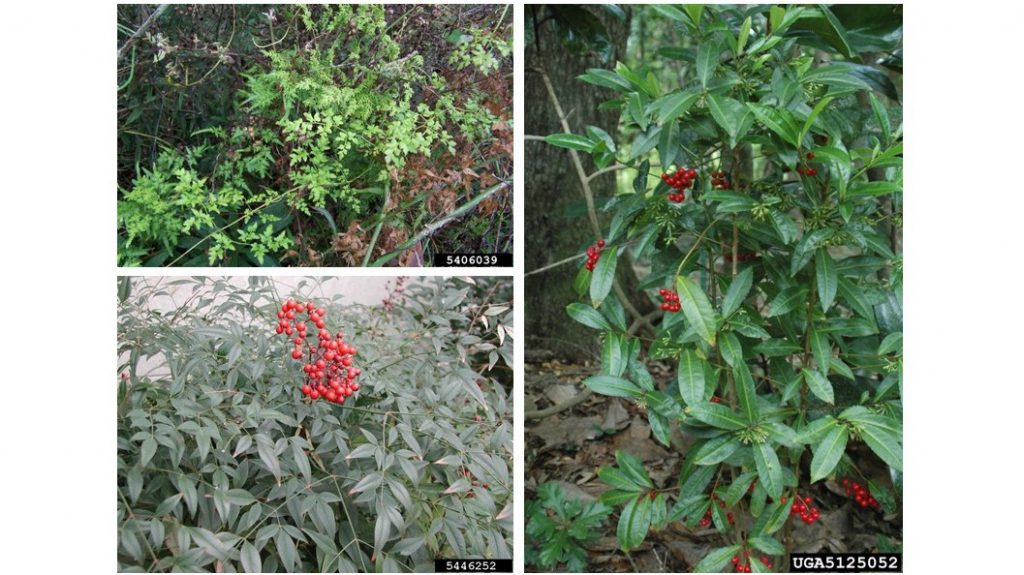
A few of the most common invasive species you may find in your north Florida landscape. Clockwise from top left – Japanese climbing fern, coral ardisia, and heavenly bamboo. Image Credit: Bugwood.org
There are several great resources from UF/IFAS to help with identification and control of invasive species, from your local county extension agents to a slew of online publications and websites. This year, the Florida Invasive Species Partnership (FISP), of which UF/IFAS is a partner, is coordinating a pandemic-safe, stay-at-home Weed Wrangle to encourage Floridians to work on controlling invasive species. If you share your efforts, you’re eligible for prizes, including weed pullers and gift certificates for native plants! For more information, check out the website for the Florida Weed Wrangle Week event – https://www.floridainvasives.org/flwww.cfm.
For more help identifying and controlling invasive species, contact your local county extension office or visit this UF/IFAS website that is a clearinghouse of invasive species information – https://sfyl.ifas.ufl.edu/natural-resources/invasive-species/.
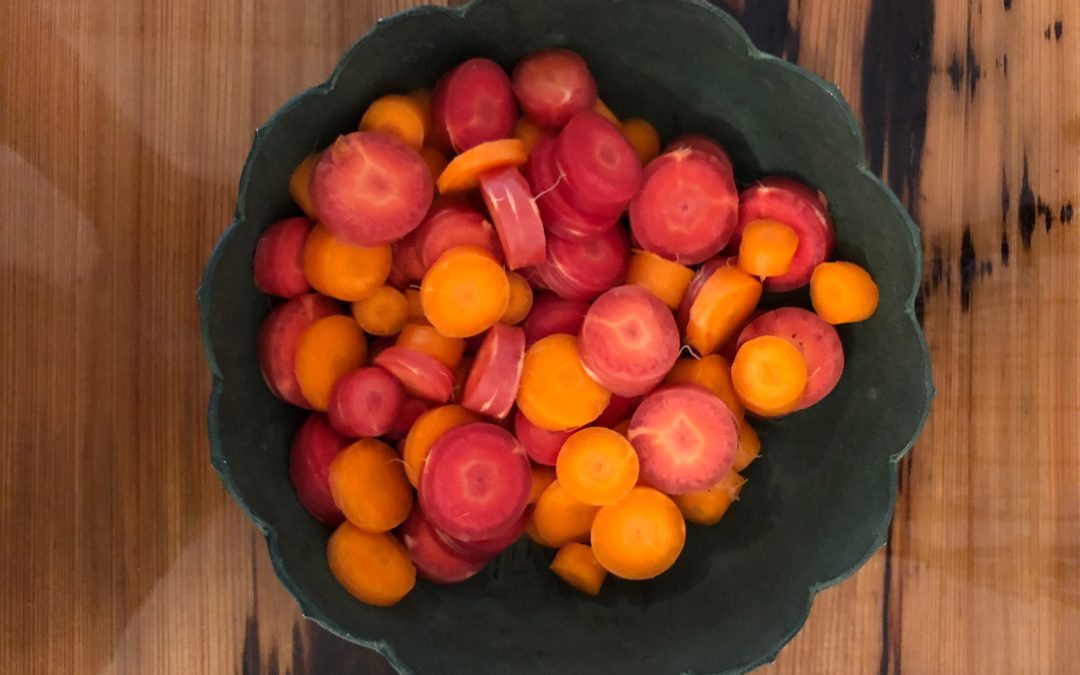
by Daniel J. Leonard | Feb 25, 2021
Carrots are synonymous with a few things: Bugs Bunny, old wives’ tales about improving eyesight, and the color orange. For centuries, orange colored carrot varieties have been the industry standard and still dominate store shelves. These days though, choices for consumers are ever expanding and thankfully home garden carrot variety selection has participated in this phenomenon! With a little searching, gardeners can now source and plant any color and/or type of carrot they desire. For instance, this winter, I planted carrots of various types in various shades of orange, purple, and red. Through this experience, I also found that not all colored carrots look, cook, or perform the same. The following is a quick primer on carrot types followed by my review of the four varieties ‘Bolero’, ‘Red Sun’, ‘Deep Purple’, and ‘Malbec’ after a season of growing.
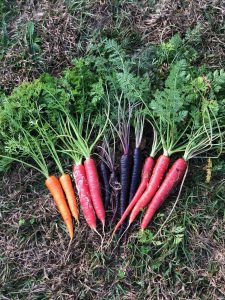
Carrot varieties (left to right): ‘Bolero’, ‘Red Sun’, ‘Deep Purple’, ‘Malbec’.
There are three main types of carrots regardless of color: Imperator, Nantes, and Chantenay. Imperator types are the extra-long, durable, sweet tasting carrots most often found in stores and are suited best to deep, loose soils. Nantes type carrots are medium length and cylindrically shaped, often with a blunt tip. Sometimes called “storage” carrots, Nantes types are easy to grow and tend to store well for long periods of time after harvest and retain their flavor well. Finally, Chantenay type carrots are excellent performers in shallower beds or soils as they are a bit shorter, possessing a conical shape with roots wider at the top and tapering to the tip, making a deep soil bed a bit less critical. I primarily grow Imperator and Nantes types as I find they give you a little more bang for the buck if you have a deeper (>6”) raised bed. Now, on to the variety reviews.
‘Bolero’ – I always have this carrot in my garden. An extremely versatile Nantes type carrot that has been a consistently high yielder for me whether I grow it in pots or in a traditional raised bed. Typical for a Nantes type, ‘Bolero’ stores very well in the refrigerator and will change your culinary life if you’ve only ever eaten carrots purchased from a store. They are excellent either fresh or cooked, with a complex, sweet taste. If I could only grow one carrot, it would be this one.
‘Malbec’ – Colored carrots have a poor reputation as far as flavor is concerned. ‘Malbec’ is the first non-orange carrot that changed my mind. This Imperator type is as flavorful as they come, deep red throughout, and is easy to grow. For some reason, ‘Malbec’ has been hard to come by the last two years, but if you spot seeds in a catalogue, online, or on a store shelf, it is well worth a purchase!
‘Red Sun’ – Winter 2020 was my first experience with ‘Red Sun’, a brand-new Nantes type carrot from Bejo Seeds. I only planted this variety because I initially could not source ‘Malbec’. Having said that, I was very pleased with ‘Red Sun’. The carrots were extremely vigorous, had excellent top and root growth and mostly held their own with ‘Malbec’ flavor-wise in the kitchen also. I would purchase ‘Red Sun’ again!
‘Deep Purple’ – Wow, they weren’t kidding when they named this variety! Most purple carrots are colored on the exterior but fade to a “normal” orange at their core. Not ‘Deep Purple’! This Imperator type is strikingly dark purple, almost black. Even the tops have a purple hue to them! Cooking them was also an interesting experience. Most colored veggies, peppers, carrots, and others lose their hue when cooked. Not this variety. Not only did ‘Deep Purple’ retain its color after cooking, my hands and cutting board turned a shade of indigo when preparing and, once put in a pan to sautee with other veggies, the juice from ‘Deep Purple’ dyed all the other veggies a deep violet! While I wouldn’t grow ‘Deep Purple’ as my main crop carrot, it definitely has a place in the garden as a tasty novelty.
Carrots are among the easiest to grow, most rewarding vegetables in the winter garden. Next fall, plant a variety of carrots in your home garden and enjoy the many types, colors and flavors that this tasty veggie has to offer! For more information on the above mentioned varieties, home carrot gardening in general, or any other horticultural topic, contact your local UF/IFAS County Extension office. Happy Gardening!
















